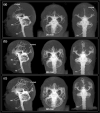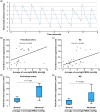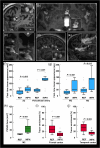Functional analysis of the human perivascular subarachnoid space
- PMID: 38443374
- PMCID: PMC10914778
- DOI: 10.1038/s41467-024-46329-1
Functional analysis of the human perivascular subarachnoid space
Abstract
The human subarachnoid space harbors the cerebrospinal fluid, which flows within a landscape of blood vessels and trabeculae. Functional implications of subarachnoid space anatomy remain far less understood. This study of 75 patients utilizes a cerebrospinal fluid tracer (gadobutrol) and consecutive magnetic resonance imaging to investigate features of early (i.e. within 2-3 h after injection) tracer propagation within the subarachnoid space. There is a time-dependent perivascular pattern of enrichment antegrade along the major cerebral artery trunks; the anterior-, middle-, and posterior cerebral arteries. The correlation between time of first enrichment around arteries and early enrichment in nearby cerebral cortex is significant. These observations suggest the existence of a compartmentalized subarachnoid space, where perivascular ensheathment of arteries facilitates antegrade tracer passage towards brain tissue. Periarterial transport is impaired in subjects with reduced intracranial pressure-volume reserve capacity and in idiopathic normal pressure hydrocephalus patients who also show increased perivascular space size.
© 2024. The Author(s).
Conflict of interest statement
PKE has a financial interest in the software company (dPCom AS, Oslo) manufacturing the software (Sensometrics Software) used for analysis of the ICP recordings. The other author (GR) declares no competing interests.
Figures









Similar articles
-
Perivascular spaces around arteries exceed perivenous spaces in the mouse brain.Sci Rep. 2024 Jul 26;14(1):17655. doi: 10.1038/s41598-024-67885-y. Sci Rep. 2024. PMID: 39085283 Free PMC article.
-
Glymphatic MRI in idiopathic normal pressure hydrocephalus.Brain. 2017 Oct 1;140(10):2691-2705. doi: 10.1093/brain/awx191. Brain. 2017. PMID: 28969373 Free PMC article.
-
Magnetic resonance imaging biomarkers of cerebrospinal fluid tracer dynamics in idiopathic normal pressure hydrocephalus.Brain Commun. 2020 Nov 6;2(2):fcaa187. doi: 10.1093/braincomms/fcaa187. eCollection 2020. Brain Commun. 2020. PMID: 33381757 Free PMC article.
-
[Dilatation of Virchow-Robin perivascular spaces (types III cerebral lacunae): radio-clinical correlations].Rev Neurol (Paris). 2007 May;163(5):561-71. doi: 10.1016/s0035-3787(07)90462-2. Rev Neurol (Paris). 2007. PMID: 17571024 Review. French.
-
Prognostic Utility of Disproportionately Enlarged Subarachnoid Space Hydrocephalus in Idiopathic Normal Pressure Hydrocephalus Treated with Ventriculoperitoneal Shunt Surgery: A Systematic Review and Meta-analysis.AJNR Am J Neuroradiol. 2021 Aug;42(8):1429-1436. doi: 10.3174/ajnr.A7168. Epub 2021 May 27. AJNR Am J Neuroradiol. 2021. PMID: 34045302 Free PMC article.
Cited by
-
Perivascular and parenchymal fluid characteristics are related to age and cognitive performance across the lifespan.Imaging Neurosci (Camb). 2025 Apr 29;3:imag_a_00549. doi: 10.1162/imag_a_00549. eCollection 2025. Imaging Neurosci (Camb). 2025. PMID: 40800815 Free PMC article.
-
Arterial pulsations and transmantle pressure synergetically drive glymphatic flow.Sci Rep. 2025 Apr 21;15(1):13798. doi: 10.1038/s41598-025-97631-x. Sci Rep. 2025. PMID: 40258946 Free PMC article.
-
Perivascular spaces around arteries exceed perivenous spaces in the mouse brain.Sci Rep. 2024 Jul 26;14(1):17655. doi: 10.1038/s41598-024-67885-y. Sci Rep. 2024. PMID: 39085283 Free PMC article.
-
Regulation of brain fluid volumes and pressures: basic principles, intracranial hypertension, ventriculomegaly and hydrocephalus.Fluids Barriers CNS. 2024 Jul 17;21(1):57. doi: 10.1186/s12987-024-00532-w. Fluids Barriers CNS. 2024. PMID: 39020364 Free PMC article. Review.
-
A review of cerebrospinal fluid circulation with respect to Chiari-like malformation and syringomyelia in brachycephalic dogs.Fluids Barriers CNS. 2025 Mar 10;22(1):25. doi: 10.1186/s12987-025-00636-x. Fluids Barriers CNS. 2025. PMID: 40065427 Free PMC article. Review.
References
MeSH terms
LinkOut - more resources
Full Text Sources

